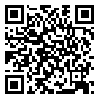Volume 7, Issue 1 (Continuously Updated 2024)
Func Disabil J 2024, 7(1): 0-0 |
Back to browse issues page
Download citation:
BibTeX | RIS | EndNote | Medlars | ProCite | Reference Manager | RefWorks
Send citation to:



BibTeX | RIS | EndNote | Medlars | ProCite | Reference Manager | RefWorks
Send citation to:
Mohammadi Dehbokr S, Torabinezhad F, Ghorbani A, Mohamadi R, Kamali M, Habibi A. Cross-cultural Adaptation of the Iranian Version of the Voice Symptom Scale. Func Disabil J 2024; 7 (1) : 282.2
URL: http://fdj.iums.ac.ir/article-1-254-en.html
URL: http://fdj.iums.ac.ir/article-1-254-en.html
Siavash Mohammadi Dehbokr1 

 , Farhad Torabinezhad1
, Farhad Torabinezhad1 

 , Ali Ghorbani1
, Ali Ghorbani1 

 , Reyhane Mohamadi *2
, Reyhane Mohamadi *2 

 , Mohammad Kamali3
, Mohammad Kamali3 

 , Amirali Habibi1
, Amirali Habibi1 




 , Farhad Torabinezhad1
, Farhad Torabinezhad1 

 , Ali Ghorbani1
, Ali Ghorbani1 

 , Reyhane Mohamadi *2
, Reyhane Mohamadi *2 

 , Mohammad Kamali3
, Mohammad Kamali3 

 , Amirali Habibi1
, Amirali Habibi1 


1- Department of Speech Therapy, Rehabilitation Research Center, School of Rehabilitation Sciences, Iran University of Medical Sciences, Tehran, Iran.
2- Department of Speech Therapy, Rehabilitation Research Center, School of Rehabilitation Sciences, Iran University of Medical Sciences, Tehran, Iran. ,mohamadi.re95@gmail.com
3- Department of Rehabilitation Management, Rehabilitation Research Center, School of Rehabilitation Sciences, Iran University of Medical Sciences, Tehran, Iran.
2- Department of Speech Therapy, Rehabilitation Research Center, School of Rehabilitation Sciences, Iran University of Medical Sciences, Tehran, Iran. ,
3- Department of Rehabilitation Management, Rehabilitation Research Center, School of Rehabilitation Sciences, Iran University of Medical Sciences, Tehran, Iran.
Abstract: (1085 Views)
Background and Objectives: This research aims to evaluate the validity and reliability of the Persian version of the voice symptom scale (VoiSS) questionnaire. We also sought to determine the best cut-off point to classify high-risk populations into controls (participants) and dysphonic patients.
Methods: The study was conducted in 3 main steps. The translation process was carried out by a pair of Iranian bilingual speech-language pathologists along with an expert panel. For the validity study, the questionnaire was administered to 268 cases that were suspected of dysphonia. Finally, to assess the reliability, the questionnaire was completed twice in 2 weeks by 40 dysphonia patients. To normalize data generation 107 individuals without dysphonia completed the P-VoiSS, after that the cutoff value of the P-VoiSS was calculated.
Results: Cronbach’s α was estimated at 0.914, and for impairment, emotional, and physical domains, it was 0.877, 0.926, and 0.725, respectively. We also estimated intra-cluster correlation (ICC) of 0.984 indicating high reproducibility of the Persian VoiSS questionnaire. The estimated intra-cluster correlation (ICC) for subscale was 0.962 for impairment, 0.989 for emotional, and 0.952 for physical domains. The Mean±SD score of the questionnaire for the healthy group was 10.1±5.9, while it was statistically higher in dysphonia patients (44.1±20.6). The statistical difference was observed in the subscales of the questionnaire between healthy and dysphonia groups (P<0.05). The exploratory factor analysis determined that the Persian VoiSS has three subtest/latent factors like the original form. We also estimate the best cut-point at 20.5.
Conclusion: The Persian adaptation of VoiSS is a dependable and effective tool that can be utilized for screening high-risk populations.
Methods: The study was conducted in 3 main steps. The translation process was carried out by a pair of Iranian bilingual speech-language pathologists along with an expert panel. For the validity study, the questionnaire was administered to 268 cases that were suspected of dysphonia. Finally, to assess the reliability, the questionnaire was completed twice in 2 weeks by 40 dysphonia patients. To normalize data generation 107 individuals without dysphonia completed the P-VoiSS, after that the cutoff value of the P-VoiSS was calculated.
Results: Cronbach’s α was estimated at 0.914, and for impairment, emotional, and physical domains, it was 0.877, 0.926, and 0.725, respectively. We also estimated intra-cluster correlation (ICC) of 0.984 indicating high reproducibility of the Persian VoiSS questionnaire. The estimated intra-cluster correlation (ICC) for subscale was 0.962 for impairment, 0.989 for emotional, and 0.952 for physical domains. The Mean±SD score of the questionnaire for the healthy group was 10.1±5.9, while it was statistically higher in dysphonia patients (44.1±20.6). The statistical difference was observed in the subscales of the questionnaire between healthy and dysphonia groups (P<0.05). The exploratory factor analysis determined that the Persian VoiSS has three subtest/latent factors like the original form. We also estimate the best cut-point at 20.5.
Conclusion: The Persian adaptation of VoiSS is a dependable and effective tool that can be utilized for screening high-risk populations.
Article number: 282.2
Type of Study: Research |
Subject:
Speech Therapy
Received: 2024/04/7 | Accepted: 2024/07/7 | Published: 2024/03/2
Received: 2024/04/7 | Accepted: 2024/07/7 | Published: 2024/03/2





